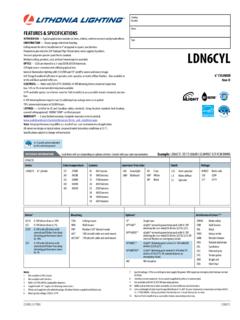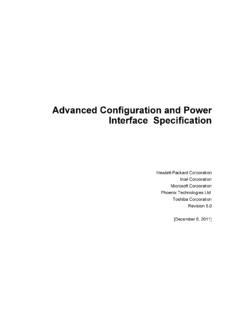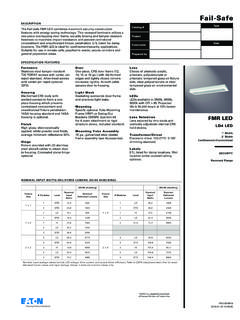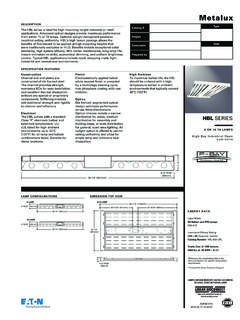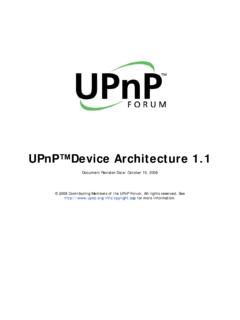Transcription of Introduction Feature - Microchip Technology
1 8-bit AVR Microcontrollers ATmega328/P. DATASHEET COMPLETE. Introduction . The Atmel picoPower ATmega328/P is a low-power CMOS 8-bit microcontroller based on the AVR enhanced RISC architecture. By executing powerful instructions in a single clock cycle, the ATmega328/P. achieves throughputs close to 1 MIPS per MHz. This empowers system designer to optimize the device for power consumption versus processing speed. Feature High Performance, Low Power Atmel AVR 8-Bit Microcontroller Family Advanced RISC Architecture 131 Powerful Instructions Most Single Clock Cycle Execution 32 x 8 General Purpose Working Registers Fully Static Operation Up to 20 MIPS Throughput at 20 MHz On-chip 2-cycle Multiplier High Endurance Non-volatile Memory Segments 32 KBytes of In-System Self-Programmable Flash program Memory 1 KBytes EEPROM.
2 2 KBytes Internal SRAM. Write/Erase Cycles: 10,000 Flash/100,000 EEPROM. Data Retention: 20 years at 85 C/100 years at 25 C(1). Optional Boot Code Section with Independent Lock Bits In-System Programming by On-chip Boot Program True Read-While-Write Operation Programming Lock for Software Security Atmel QTouch Library Support Capacitive Touch Buttons, Sliders and Wheels QTouch and QMatrix Acquisition Up to 64 sense channels Atmel-42735B-ATmega328/P_Datasheet_Compl ete-11/2016. Peripheral Features Two 8-bit Timer/Counters with Separate Prescaler and Compare Mode One 16-bit Timer/Counter with Separate Prescaler, Compare Mode, and Capture Mode Real Time Counter with Separate Oscillator Six PWM Channels 8-channel 10-bit ADC in TQFP and QFN/MLF package Temperature Measurement 6-channel 10-bit ADC in PDIP Package Temperature Measurement Two Master/Slave SPI Serial Interface One Programmable Serial USART.
3 One Byte-oriented 2-wire Serial Interface (Philips I2C compatible). Programmable Watchdog Timer with Separate On-chip Oscillator One On-chip Analog Comparator Interrupt and Wake-up on Pin Change Special Microcontroller Features Power-on Reset and Programmable Brown-out Detection Internal Calibrated Oscillator External and Internal Interrupt Sources Six Sleep Modes: Idle, ADC Noise Reduction, Power-save, Power-down, Standby, and Extended Standby I/O and Packages 23 Programmable I/O Lines 28-pin PDIP, 32-lead TQFP, 28-pad QFN/MLF and 32-pad QFN/MLF. Operating Voltage: - Temperature Range: -40 C to 105 C. Speed Grade: 0 - 4 MHz @ - 0 - 10 MHz @ - 0 - 20 MHz @ - Power Consumption at 1 MHz, , 25 C. Active Mode: Power-down Mode: A. Power-save Mode: A (Including 32kHz RTC).
4 Atmel ATmega328/P [DATASHEET] 2. Atmel-42735B-ATmega328/P_Datasheet_Compl ete-11/2016. Table of Contents 1. 1. 2. Configuration 10. 3. Ordering Information .. 11. ATmega328 .. 11. ATmega328P ..12. 4. Block 13. 5. Pin 14. 14. Pin 6. I/O 19. 7. 8. Data 9. About Code 23. 10. Capacitive Touch 24. QTouch 24. 11. AVR CPU 25. ALU Arithmetic Logic Status General Purpose Register 28. Stack 29. Instruction Execution 31. Reset and Interrupt 32. 12. AVR In-System Reprogrammable Flash Program 34. SRAM Data EEPROM Data 36. I/O Register 38. 13. System Clock and Clock 48. Clock Systems and Their Clock 49. Low Power Crystal Full Swing Crystal Low Frequency Crystal Calibrated Internal RC 128kHz Internal 55. External 56. Timer/Counter Clock Output System Clock 57.
5 Register 14. PM - Power Management and Sleep Sleep BOD Idle ADC Noise Reduction Power-Down Power-save Standby 65. Extended Standby 65. Power Reduction 65. Minimizing Power 65. Register 15. SCRST - System Control and 72. Resetting the 72. Reset Power-on External Brown-out Watchdog System 75. Internal Voltage Watchdog 76. Register 78. 16. 82. Interrupt Vectors in ATmega328 Register 84. 17. EXINT - External 87. Pin Change Interrupt Register 88. 18. 97. Ports as General Digital Atmel ATmega328/P [DATASHEET] 4. Atmel-42735B-ATmega328/P_Datasheet_Compl ete-11/2016. Alternate Port Register 113. 19. TC0 - 8-bit Timer/Counter0 with 125. Timer/Counter Clock 127. Counter 127. Output Compare Compare Match Output Modes of Timer/Counter Timing Register 137. 20.
6 TC1 - 16-bit Timer/Counter1 with 149. Block 149. 151. Accessing 16-bit Timer/Counter Clock 154. Counter 154. Input Capture 155. Output Compare 157. Compare Match Output Modes of Timer/Counter Timing 168. Register 21. Timer/Counter 0, 1 Internal Clock 186. Prescaler External Clock Register 187. 22. TC2 - 8-bit Timer/Counter2 with PWM and Asynchronous 189. 189. Timer/Counter Clock 191. Counter 191. Output Compare Compare Match Output Modes of Timer/Counter Timing Asynchronous Operation of 200. Timer/Counter 202. Register 202. Atmel ATmega328/P [DATASHEET] 5. Atmel-42735B-ATmega328/P_Datasheet_Compl ete-11/2016. 23. SPI Serial Peripheral 215. 215. SS Pin 219. Data 219. Register 220. 24. USART - Universal Synchronous Asynchronous Receiver 225. Block 225.
7 Clock Frame USART Data Transmission The USART 231. Data Reception The USART 233. Asynchronous Data Multi-Processor Communication 239. Examples of Baud Rate 240. Register 25. USARTSPI - USART in SPI 254. Clock SPI Data Modes and Frame Data AVR USART MSPIM vs. AVR Register 259. 26. TWI - 2-wire Serial 260. Two-Wire Serial Interface Bus Data Transfer and Frame Multi-master Bus Systems, Arbitration and Overview of the TWI 266. Using the Transmission 271. Multi-master Systems and Register 291. 27. AC - Analog 299. Analog Comparator Multiplexed 299. Register 300. 28. ADC - Analog to Digital Atmel ATmega328/P [DATASHEET] 6. Atmel-42735B-ATmega328/P_Datasheet_Compl ete-11/2016. 305. Starting a Prescaling and Conversion Changing Channel or Reference 310.
8 ADC Noise 312. ADC Conversion Temperature 316. Register 316. 29. DBG - debugWIRE On-chip Debug 327. 327. Physical 327. Software Break Limitations of Register 328. 30. BTLDR - Boot Loader Support Read-While-Write 330. 330. Application and Boot Loader Flash Read-While-Write and No Read-While-Write Flash Boot Loader Lock 333. Entering the Boot Loader Addressing the Flash During 335. Self-Programming the Register 344. 31. MEMPROG- Memory Program And Data Memory Lock 347. Fuse Signature 350. Calibration 351. Page 351. Parallel Programming Parameters, Pin Mapping, and 351. Parallel Serial 32. Electrical 365. Absolute Maximum Common DC Speed 368. Clock System and Reset 370. SPI Timing 371. Two-wire Serial Interface 372. ADC 374. Parallel Programming 375.
9 Atmel ATmega328/P [DATASHEET] 7. Atmel-42735B-ATmega328/P_Datasheet_Compl ete-11/2016. 33. Typical Characteristics (TA = -40 C to 85 C).. 378. ATmega328 Typical 378. 34. Typical Characteristics (TA = -40 C to 105 C).. 403. ATmega328P Typical 35. Register 36. Instruction Set 432. 37. Packaging 32-pin 436. 32-pin 28-pin 28-pin 439. 38. Errata ATmega328 440. 39. Datasheet Revision 441. Rev. B 11 441. Rev. A 06 441. Atmel ATmega328/P [DATASHEET] 8. Atmel-42735B-ATmega328/P_Datasheet_Compl ete-11/2016. 1. Description The Atmel AVR core combines a rich instruction set with 32 general purpose working registers. All the 32 registers are directly connected to the Arithmetic Logic Unit (ALU), allowing two independent registers to be accessed in a single instruction executed in one clock cycle.
10 The resulting architecture is more code efficient while achieving throughputs up to ten times faster than conventional CISC microcontrollers. The ATmega328/P provides the following features: 32 Kbytes of In-System Programmable Flash with Read-While-Write capabilities, 1 Kbytes EEPROM, 2 Kbytes SRAM, 23 general purpose I/O lines, 32. general purpose working registers, Real Time Counter (RTC), three flexible Timer/Counters with compare modes and PWM, 1 serial programmable USARTs , 1 byte-oriented 2-wire Serial Interface (I2C), a 6- channel 10-bit ADC (8 channels in TQFP and QFN/MLF packages) , a programmable Watchdog Timer with internal Oscillator, an SPI serial port, and six software selectable power saving modes. The Idle mode stops the CPU while allowing the SRAM, Timer/Counters, SPI port, and interrupt system to continue functioning.











